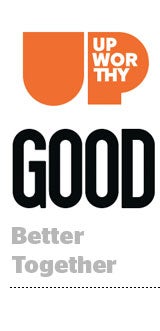The idea of accomplishing more together than apart sounds like a tagline for a social justice organization, but that’s what Upworthy and Good say happened after they merged 10 months ago to form Good Worldwide.
The two publications cater to corporations and nonprofits that want to align their brands with social causes and change.
Good excelled as a strategic partner for companies and by creating content for them, but it lacked expertise in distribution. Upworthy made do-gooder and moral outrage stories go viral on social media but has been faulted for click-bait content.
“We were competing against each other before,” said CEO Ben Goldhirsh, who led Good prior to the merger and serves as CEO of Good Worldwide. “I would be in a meeting, and the strengths Upworthy had that we didn’t have would be brought up.”
Post-merger, the two companies filled those holes in their offerings to advertisers, becoming the go-to publisher for socially aware campaigns.
Plus, the publisher met the ultimate business test: It’s profitable and growing. It recently signed six-figure deals with Hennessy, State Farm, Cigna and Nature Valley.
“Q4 will break Q3’s revenue record,” Goldhirsh said. “Q2 beat Q1, and Q3 beat Q2.”
Today, Upworthy and Good usually compete against publications outside of their niche for campaigns.
“We find ourselves most often up against premier digital companies like BuzzFeed, Vice and Vox,” said Eli Pariser, who led Upworthy before becoming president of Good Worldwide.
But making it in the branded content business is tough. Publications can find themselves stuck in a RFP cycle, where they spend much of their effort just winning clients. Even after winning a campaign, many see low renewal rates, complaining that media planners compare their custom work to run-of-the-mill, cheaper media campaigns.
“We aren’t immune to the same realities that publishers are facing,” Goldhirsh said.
But Upworthy and Good try to mix up how they work with clients to make their branded content business more efficient. The company also works with some clients, such as Airbnb and Starbucks, on an ongoing strategic basis.
On the RFP side, close rates and submissions for RFPs are both going up. And while other publishers may have to do gymnastics to make a brand align with their content, that’s not the case for Upworthy and Good.
“For a lot of the RFPs we win, we get to do work that we want to do anyway, so there is more authentic energy being put into it and, in turn, better outcomes and more renewals,” Goldhirsh added.
The publications also don’t eschew traditional banner ads. The company works directly with many clients, using banners and boxes to drive traffic or additional awareness to branded content campaigns or pitch like-minded products.
“The display we run is meant to be supplemental and as complementary as possible to the natural brands on the page,” Pariser said. “It works better than your average display.”
That’s one reason why brands continue to buy direct from Upworthy even as many move direct buys to programmatic, Goldhirsh said. “When we have a campaign that matches with our demos and values, the click-through rates are tremendous.”
With a stable of clients that includes TD Ameritrade, Cigna and Starbucks, the publisher is feeling confident and planning to hire more staff on the content and production side in 2018.
And Upworthy has dialed back its emphasis on going viral.
“Our feeling is that it’s less of a platform optimization moment and more of a back-to-basics moment, telling stories that earn your trust and attention,” Pariser said.
But the publication still uses its social know-how to serve brands. Upworthy rarely needs to boost content, and most branded content hits client goals solely through organic distribution.
“I know our content is being shared three times more than our competitors,” Goldhirsh claimed.
Some brands, such as Starbucks with its “Upstanders” project, create their own content and use Upworthy to test and tweak it for social. “They use everything we have built to make that approach maximally successful,” Pariser said.
The publications are even working with companies to move branded content measurement from clicks and shares to outcomes, whether it’s the bottom line, human resources goals, brand love or behavior change.
With the Gates Foundation, the publications measured how content changed peoples’ interest in social issues based on how they behaved weeks later. Were they more likely to sign a petition, for example?
“We are not just optimizing for media metrics, but the true outcomes,” Goldhirsch said.
Expect more work like this in the year to come, he added.
“We have the capabilities to be a key strategic partner for Fortune 500 companies, large corporations and NGOs who want to build off our media insights,” Goldhirsh said. “This [merger] puts us in a position of maximum impact.”















